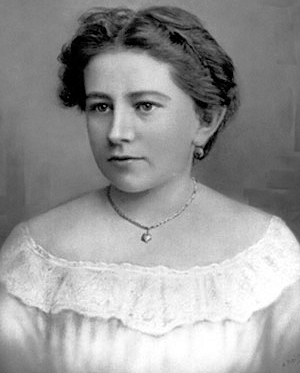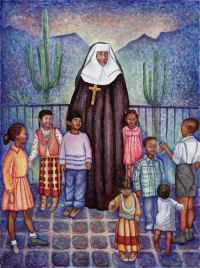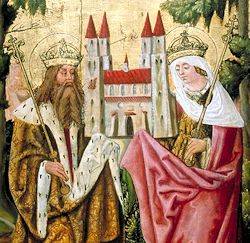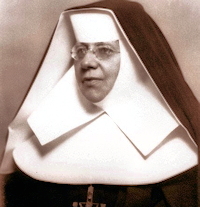Ordinary Time: March 3rd
Monday of the Eighth Week in Ordinary Time; Opt Mem of St. Katharine Drexel, Virgin (USA)
Other Commemorations: St. Cunegundes, Virgin and Empress (RM)
» Enjoy our Liturgical Seasons series of e-books!
Today is Monday of the Eighth Week in Ordinary Time. The dioceses of the United States celebrate the Optional Memorial of St. Katharine Drexel (1858-1955). Born into a wealthy Philadelphia family, Katharine took an avid interest in the material and spiritual well-being of African and Native Americans. She founded the Sisters of the Blessed Sacrament for Indians and Colored People, and opened mission schools in the West for Native Americans and in the South for African Americans. In 1915 she founded Xavier University in New Orleans. At her death, there were more than 500 sisters teaching in 63 schools.
The Roman Martyrology commemorates St. Cunegundes (d. 1040) who was Empress of the Holy Roman Empire. She and her husband, St. Henry II guarded perpetual virginity in their marriage. Together the couple carried out many pious works and practiced prayer and mortification. After his death in 1024, she went to the Convent of Kaufungen (Hesse), which she had founded. She died there in 1040 and was canonized by Pope Innocent III in 1200.
St. Katharine Drexel
 Katharine Drexel was born in Philadelphia in 1858. She had an excellent education and traveled widely. As a rich girl, she had a grand debut into society. But when she nursed her stepmother through a three-year terminal illness, she saw that all the Drexel money could not buy safety from pain or death, and her life took a profound turn.
Katharine Drexel was born in Philadelphia in 1858. She had an excellent education and traveled widely. As a rich girl, she had a grand debut into society. But when she nursed her stepmother through a three-year terminal illness, she saw that all the Drexel money could not buy safety from pain or death, and her life took a profound turn.
She had always been interested in the plight of the Indians, having been appalled by reading Helen Hunt Jackson's A Century of Dishonor. While on a European tour, she met Pope Leo XIII and asked him to send more missionaries to Wyoming for her friend Bishop James O'Connor. The pope replied, "Why don't you become a missionary?" His answer shocked her into considering new possibilities.
Back home, she visited the Dakotas, met the Sioux leader Red Cloud and began her systematic aid to Native American missions.
She could easily have married. But after much discussion with Bishop O'Connor, she wrote in 1889, "The feast of Saint Joseph brought me the grace to give the remainder of my life to the Indians and the Colored." Newspaper headlines screamed "Gives Up Seven Million!"
 After three and a half years of training, she and her first band of nuns (Sisters of the Blessed Sacrament for Indians and Colored) opened a boarding school in Santa Fe. A string of foundations followed. By 1942 she had a system of African American Catholic schools in thirteen states, plus forty mission centers and twenty-three rural schools. Segregationists harassed her work, even burning a school in Pennsylvania. In all, she established fifty missions for Native Americans in sixteen states.
After three and a half years of training, she and her first band of nuns (Sisters of the Blessed Sacrament for Indians and Colored) opened a boarding school in Santa Fe. A string of foundations followed. By 1942 she had a system of African American Catholic schools in thirteen states, plus forty mission centers and twenty-three rural schools. Segregationists harassed her work, even burning a school in Pennsylvania. In all, she established fifty missions for Native Americans in sixteen states.
Two saints met when she was advised by Mother Cabrini about the "politics" of getting her order's rule approved in Rome. Her crowning achievement was the founding of Xavier University in New Orleans, the first university in the United States for African Americans.
At seventy-seven, she suffered a heart attack and was forced to retire. Apparently her life was over. But now came almost twenty years of quiet, intense prayer from a small room overlooking the sanctuary. Small notebooks and slips of paper record her various prayers, ceaseless aspirations and meditation. She died at ninety-six and was canonized in 2000.
—Excerpted from Saint of the Day, Leonard Foley, O.F.M.
Symbols and Representation: An empress in imperial robes, sometimes holding a church.
Highlights and Things to Do:
- St. Katharine had a great love for the Eucharist, the center and source of her activity. Make a family visit to the Blessed Sacrament today.
- Read more about St. Katharine:
- St. Katharine was the daughter of Francis Anthony and Emma (Bouvier) Drexel who were generous with their money.
- Read more about the Sisters of the Blessed Sacrament which she founded. Also, see the Catholic Encyclopedia article.
- St. Katharine was originally buried in the National St. Katharine Drexel Shrine in Philadelphia, Pennsylvania, but was transferred in 2017/2018 to the Cathedral of Sts. Peter and Paul also in Philadelphia.
- St. Katharine became a spiritual mother of African Americans and Native Americans, fighting for equal rights for these neglected ethnic groups. She was particularly concerned with achieving a quality education for these people. Find out about nearby educational programs for underprivileged inner city children (an excellent parent organization concerned with this is Youth Service International) and look for ways to support them. If you cannot give any of your time, consider making a small donation.
- St. Katharine also founded Xavier University in New Orleans, the first US University for blacks.
- St. Katharine grew up in a wealthy home but her parents instilled in her the understanding that her wealth belonged to her only on loan so that she could share it with others. She gave generously and with full trust in God. Do you tithe on a regular basis? Do you encourage your children to be generous with their allowance money?
- Visit this website about Katharine Drexel that features many photos, a history and information about her shrine.
- See Catholic Cuisine for food ideas for St. Katharine.
St. Cunegundes
 Saint Cunegundes was the daughter of Siegfried, the first Count of Luxemburg, and Hadeswige, his pious wife. They instilled into her from her cradle the most tender sentiments of piety, and married her to St. Henry, Duke of Bavaria, who, upon the death of the Emperor Otho III., was chosen king of the Romans, and crowned on the 6th of June, 1002. She was crowned at Paderborn on St. Laurence's day. In the year 1014 she went with her husband to Rome, and received the imperial crown with him from the hands of Pope Benedict VIII. She had, by St. Henry's consent, before her marriage made a vow of virginity. Calumniators afterwards made vile accusations against her, and the holy empress, to remove the scandal of such a slander, trusting in God to prove her innocence, walked over red-hot ploughshares without being hurt. The emperor condemned his too scrupulous fears and credulity, and from that time they lived in the strictest union of hearts, conspiring to promote in everything God's honor and the advancement of piety.
Saint Cunegundes was the daughter of Siegfried, the first Count of Luxemburg, and Hadeswige, his pious wife. They instilled into her from her cradle the most tender sentiments of piety, and married her to St. Henry, Duke of Bavaria, who, upon the death of the Emperor Otho III., was chosen king of the Romans, and crowned on the 6th of June, 1002. She was crowned at Paderborn on St. Laurence's day. In the year 1014 she went with her husband to Rome, and received the imperial crown with him from the hands of Pope Benedict VIII. She had, by St. Henry's consent, before her marriage made a vow of virginity. Calumniators afterwards made vile accusations against her, and the holy empress, to remove the scandal of such a slander, trusting in God to prove her innocence, walked over red-hot ploughshares without being hurt. The emperor condemned his too scrupulous fears and credulity, and from that time they lived in the strictest union of hearts, conspiring to promote in everything God's honor and the advancement of piety.
Going once to make a retreat in Hesse, she fell dangerously ill, and made a vow to found a monastery, if she recovered, at Kaffungen, near Cassel, in the diocese of Paderborn, which she executed in a stately manner, and gave it to nuns of the Order of St. Benedict. Before it was finished St. Henry died, in 1024. She earnestly recommended his soul to the prayers of others, especially to her blear nuns, and expressed her longing desire of joining them. She had already exhausted her treasures in founding bishoprics and monasteries, and in relieving the poor, and she had therefore little left now to give. But still thirsting to embrace perfect evangelical poverty, and to renounce all to serve God without obstacle, she assembled a great number of prelates to the dedication of her church of Kaffungen on the anniversary day of her husband's death, 1025; and after the gospel was sung at Mass she offered on the altar a piece of the true cross, and then, putting off her imperial robes, clothed herself with a poor habit; her hair was cut off, and the bishop put on her a veil and a ring as a pledge of her fidelity to her heavenly Spouse.
After she was consecrated to God in religion, she seemed entirely to forget that she had been empress, and behaved as the last in the house, being persuaded that she was 30 before God. She prayed and read much, worked with her hands, and took a singular pleasure in visiting and comforting the sick.
Thus she passed the last fifteen years of her life. Her mortifications at length reduced her to a very weak condition and brought on her last sickness. Perceiving that they were preparing a cloth fringed with gold to cover her corpse after her death, she changed color and ordered it to be taken away; nor could she be at rest till she was promised she should be buried as a poor religious in her habit. She died on the 3d of March, 1040. Her body was carried to Bamberg and buried near that of her husband. She was solemnly canonized by Innocent III. in 1200.
—Excerpted from Lives of the Saints, by Alban Butler, Benziger Bros. ed. [1894]
Patronage: archdiocese of Bamberg, Germany; city of Bamberg, Germany; Lithuania; Luxembourg; Poland
Highlights and Things to Do:
- Read more about St. Cunegunda:
- Read about the life of St. Cunegunda's husband, King St. Henry II here.
- She and her husband Henry II are interred in the Bamberg Cathedral in Bavaria.
- Watch this short Gloria.tv video about St. Cunegunda's life.






